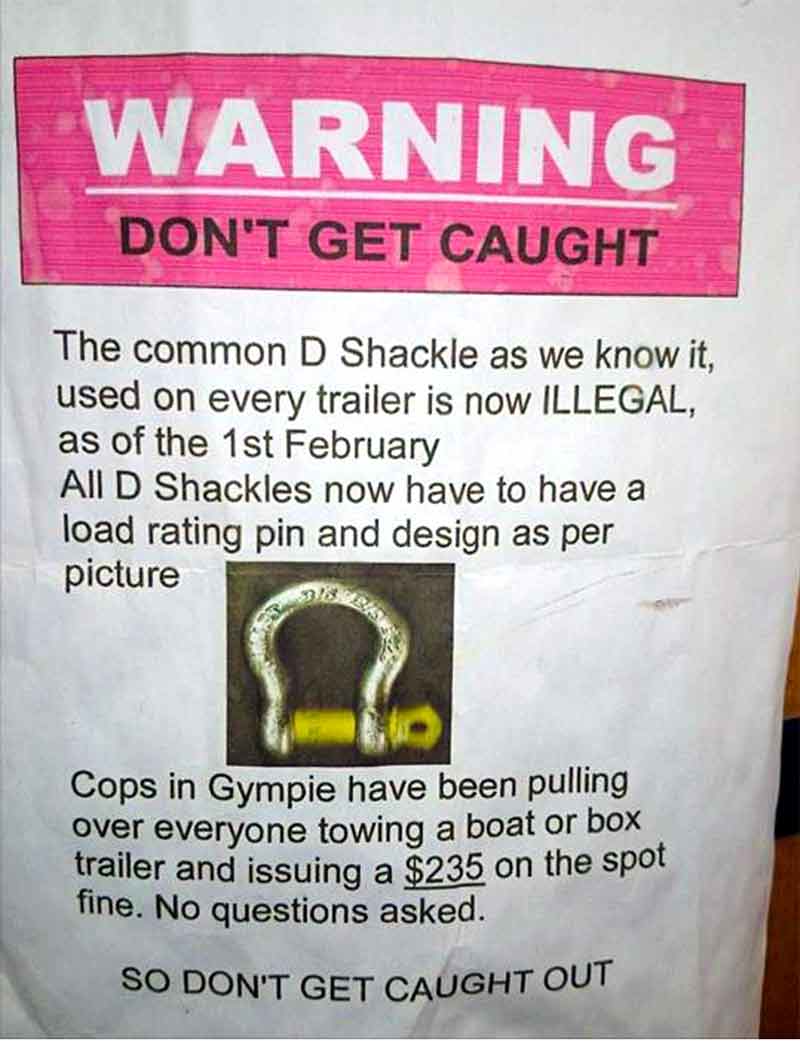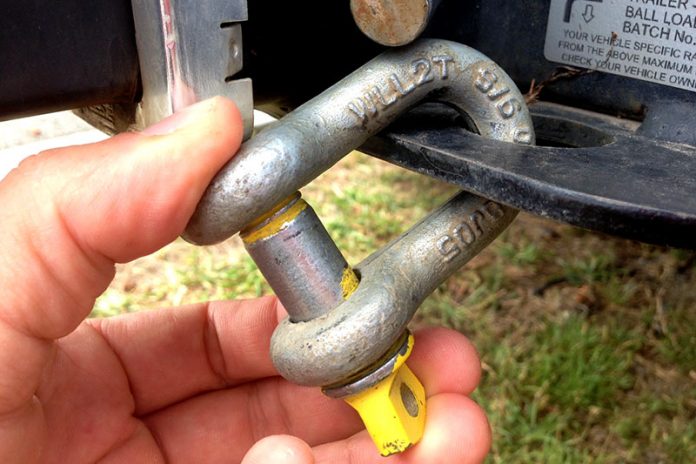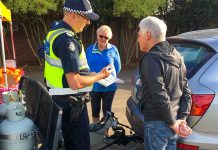An image of a poster claiming new D-shackles regulations are now in force has been causing confusion on social media. Again.
The poster – a hoax dating back to 2014 but which has recently resurfaced – claims police in Gympie, Qld, have been issuing hefty fines to people towing trailers without the use of rated D-shackles.
The best advice: if you see this image, ignore it.

But it does raise an interesting question. Should the Australian standard concerning the D-shackles we use to connect the caravan’s safety chain(s) to the towbar be changed? Should load-rated D-shackles be a requirement, rather than a suggestion?
Any towing combination is only as strong as its weakest link. The van’s safety chains are required to meet certain standards, as is the tow vehicle’s towbar. So, when it comes to D-shackles – the bit that connects the two – what gives?
D-SHACKLES STANDARDS
The relevant Australian standard, 2741-2002, doesn’t specify that rated D-shackles must be used when towing; however, various state-government departments have issued guidelines, and the Caravan Industry Association of Australia has conducted research with shackle manufacturers to develop the following checklist to refer to when buying/using D-shackles for safety chains up to 3500kg capacity.
- The shackle should meet the requirements of AS 2741-2002.
- The shackle grade should be ‘S’ or ‘6’.
- It should have a working load limit of 1000kg.
- The diameter of the shackle steel should be 10mm.
- Either a ‘bow’ or ‘dee’ design is deemed suitable; however, a bow shackle design provides a greater angular displacement.
The CIAA also notes that “a significant detail to understand is that the breaking load of a shackle is generally six times the working load limit”.
A shackle that meets the requirements of AS 2741-2002 will be stamped or marked with the manufacturer’s name, the working load limit and the grade.
Should the Australian Standards be changed to make rated D-shackles a requirement? Comment below…







Photo in the poster is not a D shackle anyway.
Both the D shackle & the Bow shackle were mentioned in the article, don’t be a smart arse.
WOW there Norman!!! .. Alan Johnston didn’t say that Bows weren’t mentioned in the article. He was only merely pointing out that the photo in reference to the hoax message poster wasn’t a D shackle despite the whole hoax message was about D shackles. The article by Max Taylor was a warning not to believe the hoax message and its wrong depiction of a D shackle.
The article by Max including the heading was about D shackles in general also. Even its 1st photo was correctly showing a D shackle.
In point 5. ” Either a ‘Bow’ or ‘D’ design is deemed suitable; however, a bow shackle design provides a greater angular displacement” is the only time a bow shackle is mentioned.
So.. Norman your comments were certainly not warranted 1 little bit!!!! .. just an outrageous!! Double Thumbs down to you sir.!!!
Oh!… by the way I use rated shackles… 2 x 2T Bow on my safety chains for my 2.7T caravan. I cant use anything larger. The chains are also stamped .. Why wouldn’t I!!!..the cost of a rated shackle from eg Bunnings – Gorilla brand are only a few more $ than a junk item from a $2 shop.
Lot of “dribble” is uttered by the likes of Peter sheherdson, that the SWL of shackles is for lifting only, and not towing. Lifting spec’s exceed line pulls by including higher SF’s
“Working Load Limit (WLL) is the maximum working load designed by the manufacturer. This load represents a mass or force that is much less than that required to make the lifting equipment fail or yield, also known as the Minimum Breaking Load (MBL). SWL or WLL are calculated by dividing the MBL by a safety factor (SF).” For lifting devices that Safety factor I understand is 8 times, far greater than something designed for dragging. The SWL rating is for straight line lift as well. Angles of Slings and Chokes can vary that WWL – something that Riggers take into account. Drivers of Tugs towing vans aren’t riggers so we get by, by using the heaviest SWL gear that is reasonable and practicable. If the tow hitch couple separated there would NOT be much of a shock load as both car and van are going in the same direction and were going at same speed at time of separation. We aint talking about the same very sudden instantaneous shock load that might be experienced in a vehicle recovery using chain where 1 vehicle is stationary and bogged, and the other moving forward (hence why we should use a recovery strap or the newer ropes to absorb that shock loading)
According to NSW RMS road rules all couplings should be marked with the manufacturers name or trade mark and rated capacity! We changed ours over!
It’s funny that the article says don’t get caught,cops have been issuing $235 on the spot fines. The poster says it comes in on Feb 1st so how can they fine them?
But people should use good stamped and rated d shackles.
Hi Barry, the poster first appeared in 2014 and was declared a hoax back then. But it is now doing the rounds again and it seems to be causing a bit of confusion, which is why we decided to publish this article.
Everyone should indeed use stamped, rated shackles.
It makes sense when every other part of the couplings must be rated, for the shackles to be rated, but they do not need to be under current NSW road regs. What they say is that the shackles must be suitable for the purpose. How would you know if an unrated shackle is suitable? The problem only arises if you have an accident where the chains and shackles are damaged. Both the RMS and the insurance assessor, not to mention the police, could be extremely interested in the fact of unrated shackles in the setup. It is probable that they would be claimed to be unsuitable and your insurance would be lost, and you may be up for some form of charge for having a below standard vehicle on the road. I changed up to rated Bow Shackles.
I love the way everyone mentions that the Insurance Company or Assessor would be interested in using non rated shackles, as an ex-assessor I know this is rubbish as the Policy Wording in an Insurance Policy statea that the unsafe or unroadworthy condition must be the cause the accident to be able to deny the claim
i.e.- if the tyres on your car at bald and you state that you skidded on a wet road your claim could be denied, however if your car had bald tyres and you were stationary and hit by another vehicle the claim could not be denied.
So I ask if your caravan is fitted with unrated shackles how would this cause the accident.
I am not surprised that you are an ex-assessor, Frosty, because your closed minded reference to others speaking “rubbish” suggests that you do not think the scene through appropriately.
If a trailer coupling, or the ball itself, fails and the trailer comes adrift, the chains and shackles are supposed to hold the trailer to the car and keep the trailer draw bar tip off the roadway. If the trailer then becomes detached from the car completely, perhaps on a busy highway, and it is clear that this happened because the unrated shackles disintegrated because they were inadequate for the task, then the shackles were inadequate, no other argument applies.
As a former insurance company assessor, would you consider that the driver had failed to use appropriate gear and was therefor ineligible for insurance payment? If you embarrass yourself by suggesting that the company should pay up it would be a shame! If the broken unrated shackles dont stop the trailer from breaking away, they are at fault for whatever happens afterwards.
Best to be sure then sorry, purely for safety I changed mine to shackles that conformed to the AS 2741 2002 standards. You say that the towing combination is only as strong as its weakest link, My main concern is the quality of the welding of the chain to the caravans draw bar, how is this checked ?
That’s a really good question—I’d love to know the answer too
If we have to use them to lift anything at work I dont see why everyone towing should not have to use rated gear considering what the shock load would be from a fully loaded Caravan breaking away !
The whole safety chain shackle saga is ridiculous. The weakest point is the chain, where it is welded to the pull, being trailer or caravan. Once heat is applied to any metal that is rated or hi tensile the weakest point is where the heat finishes, as it alters the molecular construction of the chain link. A metallurgist would certainly give a better explanation, but it was something I learnt at trade school.
The weakest link is the chain, this can not be rated as it is a lifting device, shackle are fit for purpose . If you tow 2-3 tonne a bigger or rated shackle would be common sense
Hi
My factory fitted towbar from Mitsubishi came with Rated shackles in 2014. I wonder why??
Why would you not use rated shackles anyway. The cost difference is minuscule, regardless if the whole thing is a hoax or not.
Whether towing a caravan, trailer, boat trailer or horse float they are all attached to the vehicle via a 22mm thread, Eg. the tow ball. Not much holding things together is it? It would be interesting before going through all this debate to get the facts, in the small percentage of caravans that part company with the tow vehicle, which would be a start to having a debate on facts. Then from those how many then parted company at the D shackle and what type / size shacle? We all have our own expert opinion and so do the boffins in each state government department. Full research should be applied to anything like this and not somebody that has their own opinion. (no offence intended to any private individual). once a full fact study by a reputable organisation such as the motoring associations (RACV NRMA etc.) and not some government department thinking they know better than a department in another state. Only then should a legal requirement be made, and then not by states this along with all road laws etc. should be Australia wide with no exceptions or changes made by over paid state bureaucrats trying to justify their own jobs. All Australian road laws and Driver licences along with Aus / NZ standards should be exactly the same no matter what state we live in and only then will we have accuracy in law and these time wasting debates although interesting and give some of us a laugh would not be needed.
Give us the facts then we can make an informed opinion.
You might find this interesting. It’s a circular developed by the Federal Department of Infrastructure and Regional Development that describes guidelines on the use of shackles for towing, agreed to by all states and territories in mid 2017. Note: these are guidelines, not requirements. https://infrastructure.gov.au/vehicles/administrators_circulars/files/0-1-3-1.pdf
Buy your shackles and chain from a place where they sell rigging equipment, the bigger the better as shackles are not shock tested, they are for lifting equipment only. Also I use a 3 piece shackle, with split pin and nut.
The ratings on d shakles are rated for lifting & not rated for towing , if you look at d shakle charts in any good hardware store it is listed for lifting , hope i am right with what i am wrighting
Size of the shackle I am sure is more important than a rateing a normal standard shackle 12 mm pin will hold 3 to 5 tons then elonggates but will not break till 8. Tons or more is applyed.and has always been adquate for saftey chains for trailers up to 2 tons then 16 mm pin shackle for 3 tons and 20 mm up to 4.5 tons .. failures can occure if the these sizes are much smaller. Then it is entirely apon the situation. Most break a ways happen when there is a weaker point in the system ..Watch the safty chains on trailers vans etc.see how low they are to the road .then consider how many times they
Hit the road . And how thin they can get. Over the last 50 years I have had to replace quite a number of saftey chains as well as chassis spring repairs they came in for.
I use shackles that are stamped rated for weight/towing but the problem is I drive a Sahara Landcruiser and I have a heavy rated tow hitch with a stamped tow ball to 3.5t but where the shacked are connected to the vehicle the light gauge metal that is used seems to me to light.
Is this for a reason that if the trailer for some reason comes of the tow bar that the piece of metal plate will break off and release the vehicle from the trailer!
So then why have such heavy rated shackles on the trailer??
Makes one wonder!
Any comments???
I have a Hayman Reese tow bar fitted with a 2 tonne rating and they supplied the shackles. My van is only 1250 kg so if any complaints arise I will refer them back to Hayman Reese for supplying unsuitable shackles for the purpose. An interesting case could occur..
The shackles should be equal or larger than the diameter of the chain.
Anything more than a 12mm pin will not fit through the hole in most towbars anyway. They are only about $6 each at Bunnings.
The trouble is that most people don’t or wouldn’t know the difference between a rated shackle or non rated shackle of any type.
Some rated types have the rating etched on, and not cast into them making them difficult to identify. Stainless comes to mind here.
Non rated shackles should not be sold any more IMO, and vehicle manufacturers and tow bar companies should only supply rated shackles from now on as this can only ever be a good thing.
I also think that when having a rego inspection done, if there is a tow bar on the vehicle, then we should also get the shackles inspected (which would take an extra 30 seconds to a competent inspector) as it is
a component of the vehicle, and discard and eventually weed out any non rated shackles. Yes it will take a while to do but you have to start somewhere hey.
Whilst i’m at it the safest tow bars have the tow chain attachment point welded to the tow bar receptacle, and not on the removable gooseneck section. So if the worst happens and the pin comes out of the hitch, you still have your trailer behind you.
Once you weld or galvanise any type of chain it must be treated as mild steel chain and rated as such
I believe the shackle should be rated as you see some drongos getting around with the clip type caribinier. No chance of doing anything in an emergency situation. That type of coupling should never be used.
If the shackles are to comply the standard of as 2741, I would be more worried about the weld that attaches the chain to the chassis.Should there not be a certification as per Australian standards for this weld supplied when you buy the van